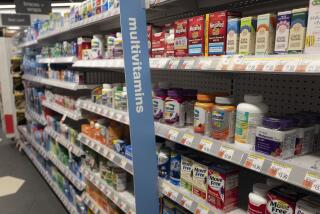Sleeping pills: bad choice as mixer
- Share via
The investigation into actor Heath Ledger’s death -- still unresolved, though medication has been suspected -- and a recent CDC report on fatal overdoses have brought national attention to the dangers of prescription drugs.
“People have a false sense of security,” says Michael Negrete, chief executive of the Pharmacy Foundation of California. “They think, ‘I see it on TV all the time. All my friends are taking it.’ People need to understand that no matter how many times they see a drug on TV, these are dangerous medications.”
With the wrong combination of pharmaceuticals, over-the-counter drugs, herbal preparations or alcohol, anyone can innocently concoct a caldron full of toil and trouble -- even a potion for death. And they do, according to the Centers for Disease Control and Prevention. Unintentional poisoning deaths, 95% of which are drug overdoses, increased from 12,186 in 1999 to 20,950 in 2004.
“There isn’t any absolutely safe medication,” says Mark Boesen, spokesman for the American Pharmacists Assn. and director of pharmacy operations for an Arizona chain called Apothecary Shops.
Recent attention has focused specifically on the risks of sleeping pills because Ledger had mentioned the drug Ambien in a recent interview, saying he’d been having difficulty sleeping, and because sleeping pills were reportedly found near his body. About 850,000 people annually misuse sedatives, including sleep aids, according to the CDC. All totaled, 14 million people misuse prescription drugs, including pain relievers, tranquilizers and stimulants.
Modern prescription sleep drugs, such as Ambien, are less risky than past generations of sleeping pills, in part because they’re eliminated from the body quicker, and the gap between a dose that helps and a dose that hurts is much greater. “The current generation of sleeping pills are safer,” says Dr. Ian Cook, professor of psychiatry at UCLA’s Semel Institute. “Still, the danger goes up when people combine medications with other meds, or with alcohol.”
Sometimes, users make mistakes in the middle of a sleepless night. “I think where people get in trouble is if they’re taking a sleeping aid, and they’re still tossing and turning,” says Boesen. Then they might take another and another. And if they’re also on an antidepressant and have had a few drinks, they could end up in serious trouble.
Other sleep drugs, even those sold over the counter, as well as prescription tranquilizers, pain medications and alcohol are especially dangerous in combination with prescription sleeping pills, says Cook.
The newer generation of prescription sleep drugs, says Dr. Greg Thompson, associate professor at USC’s School of Pharmacy, “interacts horribly with alcohol or Xanax [an anti-anxiety drug]. The way accidental deaths occur is usually with a combination of pills and alcohol.”
And the interaction is more than just addictive. “If you drink a martini and then have another martini, you’ve had two martinis,” he says. “But if you take a sleeping pill and then have a martini, you may have the equivalent of four martinis onboard.”
Over-the-counter drugs used as sleep aids, such as diphenhydramine (found in Sominex, Nytol and many types of cold and allergy medications, such as Benadryl) are far less dangerous. “With Benadryl, you probably couldn’t fit enough in your stomach to kill you,” says Thompson.
Still, combining a nonprescription sleep aid with a prescription drug or with alcohol increases the effects, and dangers, of each. “It’s a good rule of thumb not to use alcohol with any medication,” says Boesen.
The biggest danger from those over-the-counter sleep aids is that they’re often combined with acetaminophen (the active ingredient in Tylenol), and people may unwittingly take too much acetaminophen in a single day, which can lead to liver damage. Tylenol is also in a lot of prescription pain medications, such as Vicodin and Percocet. “If you accidentally double up, or take Tylenol in addition to the pain prescription, it can be really tough on the liver,” says Negrete. The damage can lead to a liver transplant, or death.
Sleeping pills, antidepressants and alcohol all act as central nervous system depressants. In combination, they act to slow things down even more, and the lethal consequence can be that a person simply stops breathing. “If you have too much alcohol, and too much of a sleep aid, and you’re also taking an antidepressant, it’s as though you’ve overdosed on the sleep aid,” says Boesen.
Too much antihistamine with alcohol can also cause trouble. “Most people can have a glass of wine or single bottle of beer with no impairment,” says Boesen. “But if they’re on an antihistamine and have one glass of wine, they may be a danger behind the wheel.” In a perfect world, patients would have one physician or one pharmacist who monitors every prescription and nonprescription medication, as well as every vitamin, supplement and herbal remedy, that they take. But in today’s healthcare system, patients can see several physicians and get their prescriptions filled at many pharmacies and mail-order outlets. Often, no one, except the patient, has the full drug picture.
“My best advice is to try to use the same pharmacy, or at least stay within the same corporation, for all your prescriptions,” says Boesen. If the pharmacist doesn’t ask for a complete list, a customer can provide one and ask the druggist to include it in his or her computerized profile, so that a potentially dangerous interaction is easier to detect, says Boesen. And people should give every doctor they see a complete list of drugs and supplements that they take, as well as keep a list themselves.
For a patient’s guide to drug interactions, go to www.pharm acist.com and search for “interaction” or www.mypharmacist .com for medication safety information. The government site www.fda.gov/cder/consum erinfo/DPAdefault.htm, has information on what consumers should know to use medications safely. Interactions and dangers are, of course, highly individual, and it’s always best to consult with a physician or pharmacist.
People can’t assume that someone else is making their pharmaceutical world safe. “People have the impression that once the FDA says it’s OK, there must be very few things I need to be concerned about,” says Boesen. “They think it’s like the highway. If the signs say you should be going 55 mph, the engineers have anticipated that you might go faster than that. They’ve engineered in some cushion. With drugs, the manufacturers don’t put any cushion in the maximum recommended dose.”
--


